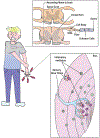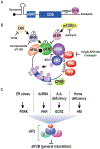RNA control in pain: Blame it on the messenger
- PMID: 31090211
- PMCID: PMC7721054
- DOI: 10.1002/wrna.1546
RNA control in pain: Blame it on the messenger
Abstract
mRNA function is meticulously controlled. We provide an overview of the integral role that posttranscriptional controls play in the perception of painful stimuli by sensory neurons. These specialized cells, termed nociceptors, precisely regulate mRNA polarity, translation, and stability. A growing body of evidence has revealed that targeted disruption of mRNAs and RNA-binding proteins robustly diminishes pain-associated behaviors. We propose that the use of multiple independent regulatory paradigms facilitates robust temporal and spatial precision of protein expression in response to a range of pain-promoting stimuli. This article is categorized under: RNA in Disease and Development > RNA in Disease Translation > Translation Regulation RNA Turnover and Surveillance > Regulation of RNA Stability.
Keywords: nociceptor; pain; plasticity.
© 2019 Wiley Periodicals, Inc.
Conflict of interest statement
No conflicts of interest
Figures


Similar articles
-
RNA-binding proteins in pain.Wiley Interdiscip Rev RNA. 2024 Mar-Apr;15(2):e1843. doi: 10.1002/wrna.1843. Wiley Interdiscip Rev RNA. 2024. PMID: 38576117 Free PMC article. Review.
-
Isolation of an mRNA binding protein homologue that is expressed in nociceptors.Eur J Neurosci. 2004 Nov;20(9):2283-93. doi: 10.1111/j.1460-9568.2004.03703.x. Eur J Neurosci. 2004. PMID: 15525270
-
Communication Is Key: 5'-3' Interactions that Regulate mRNA Translation and Turnover.Adv Exp Med Biol. 2019;1203:149-164. doi: 10.1007/978-3-030-31434-7_6. Adv Exp Med Biol. 2019. PMID: 31811634
-
[Estrogen receptors can regulate pain sensitivity. Possible explanation of certain chronic pain conditions].Lakartidningen. 2001 Apr 11;98(15):1774-8. Lakartidningen. 2001. PMID: 11374003 Review. Swedish.
-
RNA Regulation in Plant Cold Stress Response.Adv Exp Med Biol. 2018;1081:23-44. doi: 10.1007/978-981-13-1244-1_2. Adv Exp Med Biol. 2018. PMID: 30288702 Review.
Cited by
-
Molecular entrapment by RNA: an emerging tool for disrupting protein-RNA interactions in vivo.RNA Biol. 2020 Apr;17(4):417-424. doi: 10.1080/15476286.2020.1717059. Epub 2020 Jan 28. RNA Biol. 2020. PMID: 31957541 Free PMC article.
-
RNA-binding proteins in pain.Wiley Interdiscip Rev RNA. 2024 Mar-Apr;15(2):e1843. doi: 10.1002/wrna.1843. Wiley Interdiscip Rev RNA. 2024. PMID: 38576117 Free PMC article. Review.
-
Inhibition of Nonsense-Mediated Decay in Dorsal Root Ganglion Neurons.Methods Mol Biol. 2025;2962:217-235. doi: 10.1007/978-1-0716-4726-4_15. Methods Mol Biol. 2025. PMID: 40699432
-
Conserved Expression of Nav1.7 and Nav1.8 Contribute to the Spontaneous and Thermally Evoked Excitability in IL-6 and NGF-Sensitized Adult Dorsal Root Ganglion Neurons In Vitro.Bioengineering (Basel). 2020 May 16;7(2):44. doi: 10.3390/bioengineering7020044. Bioengineering (Basel). 2020. PMID: 32429423 Free PMC article.
-
A peptide encoded within a 5' untranslated region promotes pain sensitization in mice.Pain. 2021 Jun 1;162(6):1864-1875. doi: 10.1097/j.pain.0000000000002191. Pain. 2021. PMID: 33449506 Free PMC article.
References
-
- Alvarez J (2001). The autonomous axon: a model based on local synthesis of proteins. Biol Res, 34(2), 103–109. - PubMed
-
- Alvarez J, Giuditta A, & Koenig E (2000). Protein synthesis in axons and terminals: significance for maintenance, plasticity and regulation of phenotype. With a critique of slow transport theory. Prog Neurobiol, 62(1), 1–62. - PubMed
Publication types
MeSH terms
Substances
Grants and funding
LinkOut - more resources
Full Text Sources
Other Literature Sources
Medical
Research Materials

